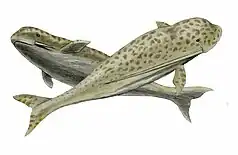Physeter
Physeter is a genus of toothed whales. There is only one living species in this genus: the sperm whale (Physeter macrocephalus).[2] Some extremely poorly known fossil species have also been assigned to the same genus including Physeter antiquus (5.3–2.6 mya) from the Pliocene of France,[3] and Physeter vetus (2.6 mya – 12 ka) from the Quaternary of the U.S. state of Georgia.[4] Physeter vetus is very likely an invalid species, as the few teeth that were used to identify this species appear to be identical to those of another toothed whale, Orycterocetus quadratidens.[5] The name is from Greek φυσητήρ (physētēr) 'blowpipe, blowhole (of a whale).'[6]
| Physeter Temporal range: [1] | |
|---|---|
| Skeleton of a sperm whale, the only extant member of the genus | |
| Scientific classification | |
| Domain: | Eukaryota |
| Kingdom: | Animalia |
| Phylum: | Chordata |
| Class: | Mammalia |
| Order: | Artiodactyla |
| Infraorder: | Cetacea |
| Family: | Physeteridae |
| Subfamily: | Physeterinae |
| Genus: | Physeter Linnaeus, 1758 |
| Type species | |
| Physeter macrocephalus Linnaeus, 1758 | |
| Species | |
References
- "Physeter macrocephalus Linnaeus 1758 (sperm whale)". Fossilworks: Gateway to the Paleobiology Database. Retrieved 17 December 2021.
- "Physeter Linnaeus 1758 (sperm whale)". Fossilworks.
- "Physeter antiquus Gervais 1849". Fossilworks.
- "Physeter vetus Leidy 1869". Fossilworks.
- Hay, Oliver Perry (1923). The Pleistocene of North America and Its Vertebrated Animals from the States East of the Mississippi River and from the Canadian Provinces East of Longitude 95. Carnegie Institution of Washington. p. 370. ISBN 9780598344724.
- Alexander Senning, The Etymology of Chemical Names (Walter de Gruyter, 2019, ISBN 3110612712), p. 280.
This article is issued from Wikipedia. The text is licensed under Creative Commons - Attribution - Sharealike. Additional terms may apply for the media files.

